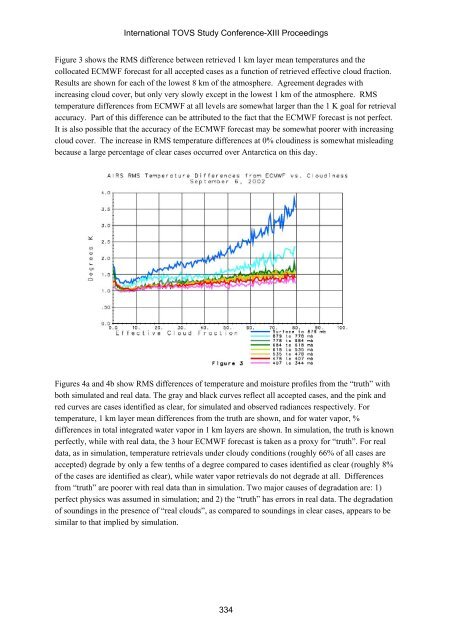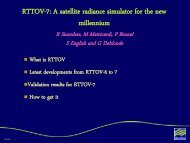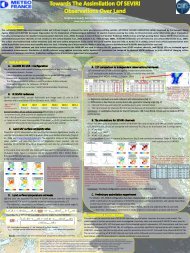Current results from AIRS/AMSU/HSB
Current results from AIRS/AMSU/HSB
Current results from AIRS/AMSU/HSB
Create successful ePaper yourself
Turn your PDF publications into a flip-book with our unique Google optimized e-Paper software.
International TOVS Study Conference-XIII Proceedings<br />
Figure 3 shows the RMS difference between retrieved 1 km layer mean temperatures and the<br />
collocated ECMWF forecast for all accepted cases as a function of retrieved effective cloud fraction.<br />
Results are shown for each of the lowest 8 km of the atmosphere. Agreement degrades with<br />
increasing cloud cover, but only very slowly except in the lowest 1 km of the atmosphere. RMS<br />
temperature differences <strong>from</strong> ECMWF at all levels are somewhat larger than the 1 K goal for retrieval<br />
accuracy. Part of this difference can be attributed to the fact that the ECMWF forecast is not perfect.<br />
It is also possible that the accuracy of the ECMWF forecast may be somewhat poorer with increasing<br />
cloud cover. The increase in RMS temperature differences at 0% cloudiness is somewhat misleading<br />
because a large percentage of clear cases occurred over Antarctica on this day.<br />
Figures 4a and 4b show RMS differences of temperature and moisture profiles <strong>from</strong> the “truth” with<br />
both simulated and real data. The gray and black curves reflect all accepted cases, and the pink and<br />
red curves are cases identified as clear, for simulated and observed radiances respectively. For<br />
temperature, 1 km layer mean differences <strong>from</strong> the truth are shown, and for water vapor, %<br />
differences in total integrated water vapor in 1 km layers are shown. In simulation, the truth is known<br />
perfectly, while with real data, the 3 hour ECMWF forecast is taken as a proxy for “truth”. For real<br />
data, as in simulation, temperature retrievals under cloudy conditions (roughly 66% of all cases are<br />
accepted) degrade by only a few tenths of a degree compared to cases identified as clear (roughly 8%<br />
of the cases are identified as clear), while water vapor retrievals do not degrade at all. Differences<br />
<strong>from</strong> “truth” are poorer with real data than in simulation. Two major causes of degradation are: 1)<br />
perfect physics was assumed in simulation; and 2) the “truth” has errors in real data. The degradation<br />
of soundings in the presence of “real clouds”, as compared to soundings in clear cases, appears to be<br />
similar to that implied by simulation.<br />
334








